#karnali pradesh
Text
Executive Director Jobs at Karnali Province Training Academy
Executive Director Jobs at Karnali Province Training Academy. Government of Karnali Province, Office of the Chief Minister and Council of Ministers, Birendranagar, Surkhet, Nepal, second time published notification regarding the requirement of an Executive Director. Interested and eligible candidates are invited to apply the post.
CAREER OPPORTUNITY
Executive Director Jobs at Karnali Province…
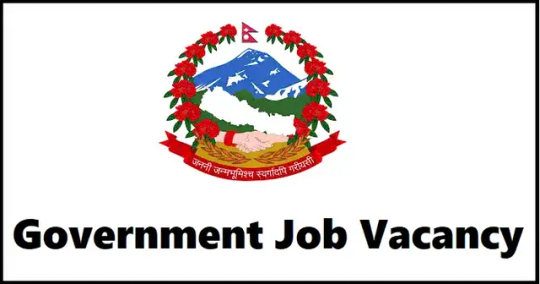
View On WordPress
#Executive Director Jobs at Karnali Province Training Academy#Government Jobs#Job Vacancy#Jobs In Nepal#Karnali Pradesh
0 notes
Text
आज शनिवारको दिनमा सार्वजनिक बिदा
आज शनिवारको दिनमा सार्वजनिक बिदा
४ भदौ, कर्णाली प्रदेश सरकारले प्रदेश स्थापना तथा सहिद दिवसको अवसरमा आज अर्थात भदौ ४ गते सार्वजनिक बिदा दिएको छ ।
प्रदेश सरकारले जारी गरिएको सूचना हेर्नुहोस्
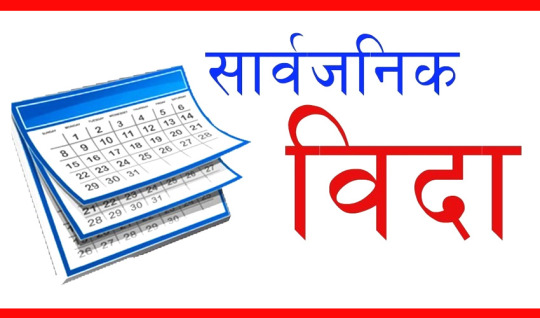
View On WordPress
#bageshworikhabar.com#bageshworinews#karnali pradesh#karnali province#आज शनिवारको दिनमा सार्वजनिक बिदा#कर्णाली प्रदेशमा आज शनिवारको दिनमा सार्वजनिक बिदा#कर्णाली प्रदेशमा सार्वजनिक बिदा#शनिवार सार्वजनिक बिदा
0 notes
Text
Spiti via Shimla or Manali – Which one is Better?

Spiti via Shimla or Manali is a common doubt among folks planning a trip to this middle land. People often tend to compare both routes in terms of scenic beauty; adventure and which side would be more fun to travel on. Spiti via Shimla or Manali is all about your budget, the time you have available for your trip and what you want to see in India's beautiful state of Himachal Pradesh, we rank them from best to worst.
If you want to go on a trip during the particularly cold season, then spiti valley packages is a better option than Manali as it is quite cold during winters in Spiti. While the weather in Manali remains very pleasant throughout the year, though it slightly cools down during winters.
The weather in Spiti remains cool throughout the year and this gives it an advantage over Manali. But if you’ve always wanted to visit beautiful places like Chandratal and Kumar Kund, this trip would be more enjoyable if you take it as part of a circuit (that covers both); because these kinds of places are located inside the King Karnali National Park which is situated between Manali and Shimla roads. Start from Shimla and head out of the valley via either Rashidpur or Dharchula, until you reach Manali. Both places are equally as beautiful and worthy of a visit.
You can also start from Manali, and head back through Spiti to your starting point in Shimla or Manali. If you know any climbing, hiking or biking skills then this route will make for a beautiful (and tough!) day out! With the above being said, there are however a few factors that can be taken into consideration about the route of your journey. Read on to know what those are.
Time of Travel
The time taken to travel from Manali to Spiti is a big factor to consider before choosing the way of travel. Though Shimla-Kazeti road remains open throughout the year, there are only two months when you can take this route; namely June and early October. If you are planning a trip to Shimla and Manali, there are some good options. You can either head directly from Shimla to Manali or go via Delhi, Dehradun, and Manali. But it cannot be left unanswered that the timings of travel during this time are different than what you might be used to.
Days of Travel
If you are traveling from Shimla or Manali, it is much easier to reach Kaza as compared to Seoni. So as you can see, while there are multiple reasons for this; it is quite obvious that on the basis of convenience and speed, travelling between Manali – Kaza route will be considered a better option. But with this, you should also take into fact that this is only possible in the months of June to September.
Chandratal
On the way to Spiti valley, Chandratal lake is a must visit. This lake is located on Manali trip to Kaza route and is less than 4kms from the Manali airport. The trek to Chandratal lake is traversed through an beautiful forest with views of snow capped mountains in all directions. There are only two small towns next to it, which are Bhuntar and Kaza and can be reached in less than 2 hours drive.
Rohtang Permits
Rohtang Permits has become a troublesome task for both the locals and travelers. Do not get me wrong, I do agree that steps were needed to be taken to preserve the Eco-system and keep the pass pollution free. But from a traveller’s point of view, this now means staying at Manali for an entire day while working to get the permits needed to cross over Rohtang Pass. Rohtang permit required for vehicles traveling from Manali side. If you were coming from Spiti group tour to Manali, there is no permit needed at all. This is a great reason to start your journey from Shimla side and exit at Manali; thus saving a day in the trip.
Acute Mountain Sickness
Acute Mountain Sickness is the condition that strikes a person after spending some time at a high altitude. This can be caused by a sudden change in the weather conditions at the top of Himalayas, severe consequences of altitude sickness or even during your stay in other destinations like Kaza and Manali package, which are also high altitudes. We recommend that you should stay close to your car and avoid riding if you suffer from acute altitude sickness. At times, the increase in altitude is gradual and spread evenly over a few days. If you were traveling with family or your elders, then you must start the journey from Shimla side and hence, avoid them from suffering altitude sickness.
Off-Roading
Your off-roading adventure starts at Manali. Over a stretch of around 110 kilometres, the road will gradually switch from asphalt to dirt and will be patched in parts. The infamous stretch between Batal and Gramphoo is particularly tricky - while on one hand there's a pleasant climb over stone steps and rock faces, the other side has some mud pits, pot holes and even tree roots below. This road is like no other. It will challenge your senses, take you to heights and leave you on the same spot. This 60 kilometres long road has so many water crossings that you will not be able to keep your shoes dry if you were on a bike. So if you want to go off-roading, then go via Manali and return the same way.
Only see Spiti
If you are already quite familiar with Kinnaur and Spiti Valley tour package as well as your ticket that has already been reserved to travel by road, then you should consider travelling via Manali instead. This will save you all the time on the road coming from Shimla side; time that gives you the option of visiting remote areas within Spiti.
Spiti via Shimla or Manali – Which one is Better?
It would be hard and unfair to really call one road better than the other. It will just depend on your own preference based on the factors I mentioned above. I do hope that this information was of help.
0 notes
Text
कृषिमन्त्रीमा नियुक्त शाहीद्वारा शपथग्रहण
कर्णाली प्रदेशका नवनियुक्त भूमि व्यवस्था, कृषि तथा सहकारीमन्त्री चन्द्रबहादुर शाहीले पद तथा गोपनीयताको शपथग्रहण गर्नुभएको छ ।
कर्णाली प्रदेशका नवनियुक्त भूमि व्यवस्था, कृषि तथा सहकारीमन्त्री चन्द्रबहादुर शाहीले पद तथा गोपनीयताको शपथग्रहण गर्नुभएको छ ।
मन्त्री शाहीले कर्णाली प्रदेशका प्रमुख तिलक परियारसमक्ष मङ्गलबार शपथग्रहण गर्नुभएको हो । शाहीलाई कर्णाली प्रदेश सरकारका मुख्यमन्त्री जीवनबहादुर शाहीले मङ्गलबार नियुक्त गर्नुभएको थियो । मुख्यमन्त्री शाहीले भूमि व्यवस्था, कृषि तथा सहकारीमन्त्रीमा शाहीलाई नियुक्त गरेपछि…
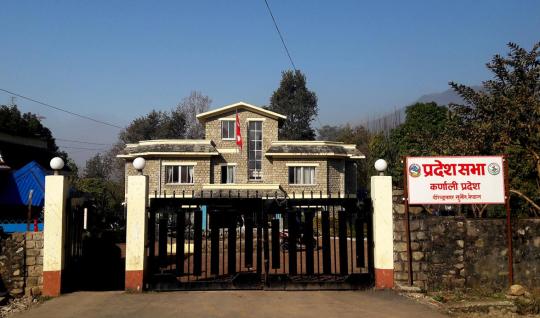
View On WordPress
0 notes
Text
कृषिमन्त्रीमा नियुक्त शाहीद्वारा शपथग्रहण
कर्णाली प्रदेशका नवनियुक्त भूमि व्यवस्था, कृषि तथा सहकारीमन्त्री चन्द्रबहादुर शाहीले पद तथा गोपनीयताको शपथग्रहण गर्नुभएको छ ।
कर्णाली प्रदेशका नवनियुक्त भूमि व्यवस्था, कृषि तथा सहकारीमन्त्री चन्द्रबहादुर शाहीले पद तथा गोपनीयताको शपथग्रहण गर्नुभएको छ ।
मन्त्री शाहीले कर्णाली प्रदेशका प्रमुख तिलक परियारसमक्ष मङ्गलबार शपथग्रहण गर्नुभएको हो । शाहीलाई कर्णाली प्रदेश सरकारका मुख्यमन्त्री जीवनबहादुर शाहीले मङ्गलबार नियुक्त गर्नुभएको थियो । मुख्यमन्त्री शाहीले भूमि व्यवस्था, कृषि तथा सहकारीमन्त्रीमा शाहीलाई नियुक्त गरेपछि…
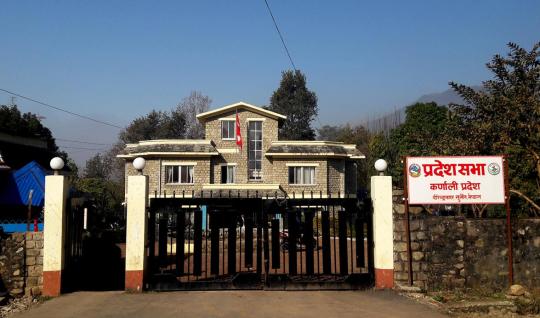
View On WordPress
0 notes
Text
Sudurpashchim Pradesh Lok Sewa Aayog Vacancy for 5th Level Prabidhik Sahayak
Sudurpashchim Pradesh Lok Sewa Aayog Vacancy for 5th Level Prabidhik Sahayak
Sudurpashchim Pradesh Lok Sewa Aayog Vacancy for 5th Level Prabidhik Sahayak,12 Post, Age Limit, Eligibility, Admit Card, Exam Date, and Full Notification State Public Service Commission Far Western Province, Dhangadhi, Kailali (Administration, Planning and Information Publication Branch) Nepal Education Service, Education Administration Group, 5th Level, Technical Assistant under State Civil…

View On WordPress
#"psc sudurpashchim gov np#http ppsconline sudurpashchim gov np#Lok Sewa Aayog Karnali Pradesh Vacancy#lok sewa aayog vacancy 2077 2078#sudurpaschim lok sewa aayog syllabus#sudurpaschim lok sewa aayog vacancy#sudurpaschim lok sewa aayog website#sudurpaschim province website#Sudurpashchim Pradesh Lok Sewa Aayog Vacancy for 5th Level Prabidhik Sahayak#www psc gov np 207778
0 notes
Text
Postal code of Karnali
Postal code of Karnali
Province number 6 Karnali Pradesh
Humla
Humla D.P.O. 21000Muchu 21003Lali 21004Sarkegadh 21005Darma 21007Srinagar 21008
Mugu
Mugu D.P.O. 21100Rowa 21102Pulu 21103Sorubarma 21105Rara 21106Sukhadhik 21107Gumtha 21109Dhainkot 21110
Jumla
Jumla D.P.O. 21200Dillichaur 21202Tatopani 21204Malikathata 21205Kalikakhetu 21206Narakot 21207Hatsinja 21208Chhautha 21209
Kalikot
Kalikot D.P.O.…

View On WordPress
0 notes
Video
Dolpa District, a part of Karnali Pradesh, is one of the seventy-seven districts of Nepal. The district, with Dunai as its district headquarters, covers an area of 7,889 km² and has a population of 36,700. • • . 📸✈@xandip_messi . Stay safe and Keep your travelling dreams alive 😊 . #storiesofhimalayas #himalayas #dolpa (at Dolpa District) https://www.instagram.com/p/CBheYeVFcZI/?igshid=1p2wl739nvalf
5 notes
·
View notes
Text
पत्रकार सम्मेलन गर्दै राष्ट्रिय स्वतन्त्र पार्टी नामको विषयमा चौतर्फी आलोचना
पत्रकार सम्मेलन गर्दै राष्ट्रिय स्वतन्त्र पार्टी नामको विषयमा चौतर्फी आलोचना
रवि लामिछाने नेतृत्वको राष्ट्रिय स्वतन्त्र पार्टीले आज पत्रकार सम्मेलन गर्ने भएको छ । पार्टी प्रवक्ता मुकुन्द ढकालका अनुसार आज दिउँसो ४ बजे रिपोर्टर्स क्लबमा स्वतन्त्र पार्टीको पहिलो पत्रकार सम्मेलन तय भएको हो । लामिछानेले ७ असारमा मात्र नयाँ दलको घोषणा गरेका थिए । पार्टीको नाम स्वतन्त्र राखिएकामा चौतर्फी आलोचना भइरहेको छ । यसबारे पत्रकार सम्मेलनमा थप प्रष्ट पारिने बताइएको छ ।
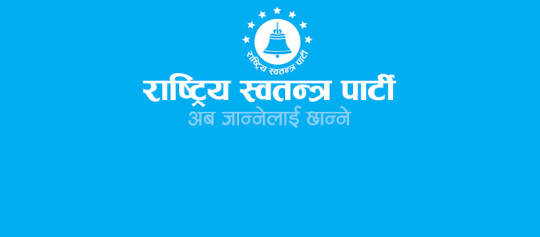
View On WordPress
#cpn uml#karnali pradesh#new party#online news#prakash saput new song#press meet#rabi lamichhane#rabi lamichhane party#rastriya swotantra party#thakurbabanews
0 notes
Text
कर्णाली प्रदेशमा सार्वजनिक बिदा
कर्णाली प्रदेश सरकारले कोजाग्रत पूर्णिमाको अवसरमा आज प्रदेशभर सार्वजनिक बिदा दिएको छ ।
कर्णाली प्रदेश सरकारले कोजाग्रत पूर्णिमाको अवसरमा आज प्रदेशभर सार्वजनिक बिदा दिएको छ । कोजाग्रत पूर्णिमा मङ्गलबार भए पनि पूर्णिमा व्रत एवं कात्तिक स्नान आजदेखि सुरु हुने भएकाले प्रदेश सरकारले आज बिदा दिएको हो ।
विसं २०७८ वैशाख १७ गते बसेको प्रदेश मन्त्रिपरिषद् बैठकले असोज शुक्ल पूर्णिमाको अवसरमा कात्तिक ३ गते बिदा दिने निर्णय गरेको थियो । आन्तरिक मामिला तथा कानून मन्त्रालयले प्रदेशस्थित सबै…
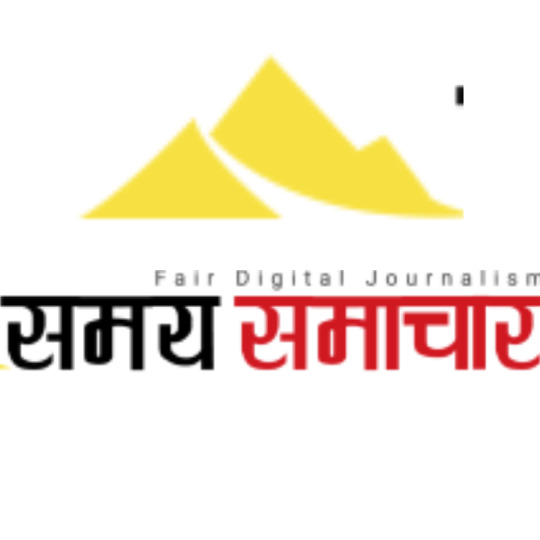
View On WordPress
0 notes
Text
09-05-2020 Current affairs & Daily News Analysis

Environment for the Americas Launches World Migratory Bird Day 2020
This year the theme of World Migratory Bird Day is “Birds Connect Our World” to highlight the importance of conserving the ecological connectivity that support the natural movements of migratoy birds.
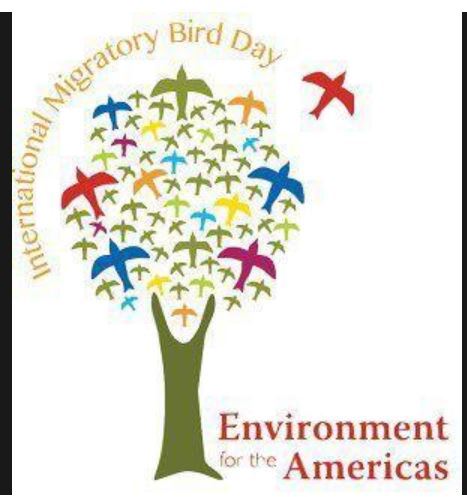
About:
What is it? WMBD is an annual awareness-raising campaign highlighting the need for the protection of migratory birds and their habitats.
History: The annual day was initiated in 2006.
Day of Observance: Since 2018, it is celebrated twice a year, on the second Saturday in May and in October.
Who organizes WMBD? The campaign is organized by two international wildlife treaties administered by the United Nations Environment Programme (UNEP) – the Convention on the Conservation of Migratory Species of Wild Animals (CMS), and the African-Eurasian Migratory Waterbird Agreement (AEWA) - together with Environment for the Americas (EFTA).
Source : United Nations ( Environment )
Read UPSC Current affairs and Daily News Analysis from Best IAS Coaching in Bangalore Vignan IAS Academy
Global Humanitarian Response Plan: COVID-19 (April – December 2020) GHRP May Update
The United Nations and partner agencies have launched a 6.7 billion US dollar global appeal to fight the COVID-19 pandemic, more than trebling an earlier appeal made by the UN chief.
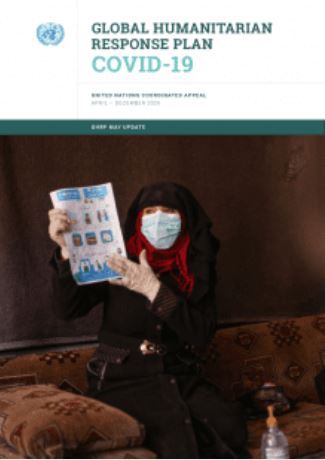
About:
The COVID-19 Global Humanitarian Response Plan was launched on March 25th, but with humanitarian needs rising, the plan is calling for an injection of 6.7 billion US dollars for the remainder of 2020.
The plan puts special focus on more vulnerable countries and combating food insecurity and gender-based violence.
The updated appeal adds nine vulnerable countries to the 54 nations covered in the initial appeal -- Benin, Djibouti, Liberia, Mozambique, Pakistan, the Philippines, Sierra Leone, Togo and Zimbabwe.
Source : The Hindu ( International )
Read UPSC Current affairs and Daily News Analysis from Best IAS Coaching in Bangalore Vignan IAS Academy
Coronavirus: India rates '100' on Stringency Index
A Stringency Index created by Oxford University shows how strict a country’s measures were responding to the Covid-19 outbreak, and at what stage of the spread it enforced these.
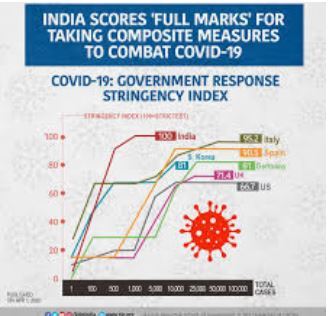
About:
It is among the metrics being used by the Oxford COVID-19 Government Response Tracker.
It tracks 17 indicators of government response. These indicators examine containment policies such as school and workplace closings, public events, public transport, stay-at-home policies.
The Stringency Index is a number from 0 to 100 that reflects these indicators. A higher index score indicates a higher level of stringency.
Important Info :
Key findings on India:
The Stringency Index has found that India indeed had one of the strongest lockdown measures in the world — at a 100 score since March 22.It was relaxed slightly on April 20 after the government eased norms for certain workplaces in regions outside the red zones.In countries such as the UK, the US, and India, the Oxford graphs find that the death curve has not flattened after strictest measures were enforced.
Source : Indian Express ( Polity & Governance )
Read UPSC Current affairs and Daily News Analysis from Best IAS Coaching in Bangalore Vignan IAS Academy
INSTITUTE OF NUCLEAR MEDICINE & ALLIED SCIENCES (INMAS)
Personal Protective Equipment (PPE) designed and produced by Indian Navy has been tested by INMAS and is certified to be mass produced and used in clinical COVID situations. INMAS is a DRDO organization tasked with testing and certification of PPE.
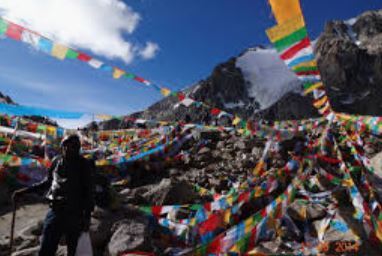
About:
Parent Body: INMAS is a laboratory of the Defence Research and Development Organisation (DRDO).
Established in: 1961.
Location: New Delhi.
Important Info :
Mandate:
This multidisciplinary laboratory is engaged in R&D activities in the field of Radiation, Imaging Sciences, CBRN technologies, Nuclear medicine research and responding to nuclear accidents and explosions.Since 1960s it offers a two-year diploma in radiation medicine, making it the first formal training program in nuclear medicine in the world.A major development in the recent past has been the establishment of NMR, PET-Cyclotron facility that has contributed towards development of technologies for enhancing combat efficiency besides providing clinical research to the Armed forces.
Source : All India Radio ( Science & Technology )
Read UPSC Current affairs and Daily News Analysis from Best IAS Coaching in Bangalore Vignan IAS Academy
Now you can drive to Kailash Mansarovar from Delhi; first batch flagged off
Defence Minister inaugurated the Link Road to Kailash Mansarovar via video conferencing. This link road was constructed by Border Roads Organization (BRO).
About:
The link road connects Dharchula to Lipulekh (China Border) which is known as Kailash-Mansarovar Yatra Route.
The Darchula – Lipulekh road is an extension of Pithoragarh-Tawaghat-Ghatiabagarh road.
It originates from Ghatiabagarh and terminates at Lipulekh Pass, the gateway to Kailash Mansarovar. In this 80 Km road, the altitude rises from 6000 feet to 17,060 feet.
At present, the travel to Kailash Mansarovar takes around two to three weeks through Sikkim or Nepal routes. Lipulekh route had a trek of 90 Km through high altitude terrain and the elderly yartris faced lot of difficulties. Now, this yatra will get completed by vehicles.
Important Info :
Mount Kailash?
Mount Kailash is a 6,638 m high peak in the Kailash Range (Gangdise Mountains), which forms part of the Transhimalaya in the Tibet Autonomous Region of China.The mountain is located near Lake Manasarovar and Lake Rakshastal, close to the source of some of the longest Asian rivers: the Indus, Sutlej, Brahmaputra, and Karnali/Ghaghara.
Source : All India Radio ( Geography )
Read UPSC Current affairs and Daily News Analysis from Best IAS Coaching in Bangalore Vignan IAS Academy
What are the safeguards against chemical disasters in India?
A gas leak from LG Polymers factory situated on the outskirts of Visakhapatnam, Andhra Pradesh killed at least 11 people. The law in India provides protection to victims of such chemical disasters.

Here’s a look at some of these provisions:
Bhopal Gas Leak (Processing of Claims) Act, 1985 gives powers to the central government to secure the claims arising out of or connected with the Bhopal gas tragedy.
The Environment Protection Act, 1986 gives powers to the central government to undertake measures for improving the environment and set standards and inspect industrial units.
The Public Liability Insurance Act, 1991 is an insurance meant to provide relief to persons affected by accidents that occur while handling hazardous substances.
Under the National Environment Appellate Authority Act, 1997, the National Environment Appellate Authority (NEAA) can hear appeals regarding the restriction of areas in which any industries shall not be carried out or shall be carried out subject to certain safeguards under the Environment (Protection) Act, 1986.
National Green Tribunal, 2010, provides for the establishment of a National Green Tribunal for expeditious disposal of cases related to environmental protection and conservation of forests.
Source : Indian Express ( Disaster Management )
Read UPSC Current affairs and Daily News Analysis from Best IAS Coaching in Bangalore Vignan IAS Academy
Facebook's "Supreme Court", New Oversight Board, Can Overrule Zuckerberg
Facebook’s new oversight board — similar to an independent, internal court — has chosen National Law School of India University (NLSIU) Vice-Chancellor Sudhir Krishnaswamy as one of its first 20 members.

About:
Working: The board will make final and binding decisions on what content should be allowed or removed from Facebook and Instagram, based on respect for freedom of expression and human rights.
Power: All decisions taken by the board will be implemented by Facebook as long as they do not violate the law.
Significance: To moderate content posted on social media platforms, Facebook’s oversight board represents a new model of content moderation for Facebook and Instagram. Notably, the Board will review content referred to it by both users and Facebook
Composition: The board comprises of 20 independent Members from over 27 countries which includes former heads of state, judges, journalists, human rights rapporteurs etc.
Removal of Members: the board members are independent of the company, and cannot be removed by Facebook based on their decisions.
Important Info :
Sudhir Krishnaswamy?
Sudhir Krishnaswamy is the India Vice-Chancellor of the National Law School of India University.He is also co-founder of the Center for Law and Policy Research, an advocacy organization that has substantially advanced the rights of LGBTQ+ and transgenders in India through impact litigation.
Source : Indian Express ( Polity & Governance )
Read UPSC Current affairs and Daily News Analysis from Best IAS Coaching in Bangalore Vignan IAS Academy
PRIME MINISTER’S RESEARCH FELLOWSHIP (PMRF) SCHEME
Union HRD Ministry has recently carried out various amendments in Prime Minister’s Research Fellowship Scheme to boost research in the country.

Key Amendments:
To boost research, a dedicated Division is being created in the ministry with the name of "Research and Innovation Division". This division will be headed by a director who will be coordinating research work of various institutions coming under MHRD.
Now for the students from any recognised institute/ university (other than IISc/ IITs/NITs/IISERs/IIEST/CF IIITs), the requirement of GATE Score is reduced to 650 from 750 apart from minimum CGPA of 8 or equivalent.
Starting Academic Year 2020-21, there will be two channels of entries, one direct entry and lateral entry. In lateral entry, the students, who are pursuing PhD in PMRF granting institutions can also apply to become fellow under the scheme as per new guidelines.
Important Info :
Background:
The Prime Minister’s Research Fellows (PMRF) Scheme has been designed for improving the quality of research in various higher educational institutions in the country. With attractive fellowships, the scheme seeks to attract the best talent into research.The scheme was announced in the Budget 2018-19.The institutes which can offer PMRF include all the IITs, all the IISERs, Indian Institute of Science, Bengaluru and some of the top Central Universities/NITs that offer science and/or technology degrees.
Source : PIB ( Science & Technology )
Read UPSC Current affairs and Daily News Analysis from Best IAS Coaching in Bangalore Vignan IAS Academy
TIGER POPULATION IN SUNDERBANS
According to the latest estimation of tiger numbers in the Indian Sunderbans by the West Bengal Forest Department, the tiger count for the year 2019-20 rose to 96, from 88 in 2018-19.

About:
The Sunderbans delta, spread over India and Bangladesh, is the only mangrove forest in the world inhabited by tigers.
The increase in the number by eight was significant as it was the biggest annual jump reported from the Sunderbans.
The Sunderban mangrove forest is spread over 2,585 sq. km and includes the Sundarban Tiger Reserve and the 24 Parganas (South) Division.
Estimation of the number of tigers in the Sunderbans, a world heritage as well as a Ramsar site, has always been a challenge because of the difficult terrain that comprises dense mangrove forests, with creeks and rivulets, and floods twice a day during the high tides.
Source : The Hindu ( Environment )
Read UPSC Current affairs and Daily News Analysis from Best IAS Coaching in Bangalore Vignan IAS Academy
CENTRE OF EXCELLENCE FOR COIR APPLICATIONS
Coir Board signed a MoU with the Indian Institute of Technology (IIT)-Madras, to establish a Centre of Excellence for Coir Applications.
About:
The Centre of Excellence aims at furthering the research work done so far in the coir sector with the support of IIT, Madras.
It will also support the development of relevant technology and evolve standards for production and processing through specific projects and monitor research projects.
Coir Board will provide a financial assistance of 5 crore rupees initially for a period of two years for the establishment and running of the Centre of Excellence.
Important Info :
Coir Board?
The Coir Board is a statutory body established by the Government of India under the Coir Industry Act 1953 for the promotion and development of the coir (coconut fibre) industry in India.It is based in Kochi and Alappuzha.The board functions under the Ministry of Micro, Small and Medium Enterprises (MSME).
Source : All India Radio ( Economy)
Read UPSC Current affairs and Daily News Analysis from Best IAS Coaching in Bangalore Vignan IAS Academy
Read UPSC Current affairs and Daily News Analysis from Top IAS Academy in Bangalore Vignan IAS Academy
Daily Current affairs and News Analysis
Best IAS Coaching institutes in Bangalore Vignan IAS Academy
Contact Vignan IAS Academy
Enroll For IAS Foundation Course from Best IFS Academy in Bangalore
Read the full article
#09-05-2020VignanIASCurrentAffairs#BestIASAcademyinBangalore#topiascoachinginbangalore#Top5IASCoachinginBangalore#TopIASInstitute
0 notes
Photo

Government Job: 201 Vacancies VACANCY ANNOUNCEMENT Social Development Ministry, Karnali Pradesh In today’s tough job market, you must do all that you can to stand out.
0 notes
Text
माटू हमरू, पाणी हमरू, हमरा ही छन यी बौण भी… पितरों न लगाई बौण, हमुनही त बचौण भी।
(Soil ours, water ours, ours are these forests. Our forefathers raised them, it’s we who must protect them —Old Chipko Song )

The state of Uttarakhand, earlier referred to as Uttaranchal, is located in the northern part of India. Often called as the Land of Gods – Dev Bhumi owing to the innumerable temples and teerth or pilgrimage sites found throughout the state. The famous Char Dham (Kedarnath, Badrinath, Gangotri, and Yamunotri), considered to be the among the holiest sites in India, are in Uttarakhand. Besides the religious significance of the state, Uttarakhand is also well known for its natural beauty that comprises of snow capped mountains, both low and high altitude lakes and associated wetlands, bugiyals or high altitude meadows, and dense forests that are a home to many exotic and diverse flora and fauna.
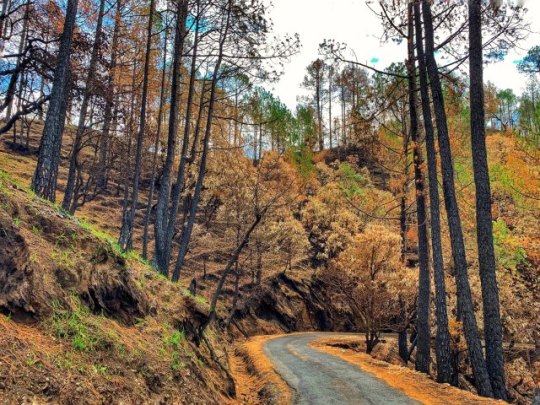
The beautiful forests of Binsar in Uttarakhand (Almora)

Beautiful view of snow peaks from Lansdowne in Uttarakhand (Pauri)
The name Uttarakhand has originated from two Sanskrit words: uttara (उत्तर) meaning north, and khaṇḍa (खण्ड) meaning land. The name is mentioned in many of the early Hindu texts, wherein it referred to the area of Kedarkhand (modern Garhwal) and Manaskhand (modern Kumaon). In ancient India, Uttarakhand was used to denote the central stretch of the Himalayas.
“The land north of Gangadwar is known to the wise as Paradise Ground. Apart from this land, the rest is called Earth elsewhere”― Kedarkhand Skanda Purana.
The state of Uttarakhand was formed on 9th November 2000, by carving out the Himalayan and some adjoining districts in the foothills of Uttar Pradesh, and was made into the 27th state of the Republic of India. It shares borders with the state of Himachal Pradesh to the north west, Tibet Autonomous Region (of China) on the north, Nepal on the east, and the state of UP in the south, while doing a touch and go with Haryana in the west (the Hathni Kund Barrage area from where the Yamuna waters are diverted to Haryana). Uttarakhand is the birth place of four large river systems: the Ganga, Yamuna, Ramganga, and Sharda. The state has two divisions: Garhwal and Kumaon with a total of 13 districts.
Divisions Districts Kumaon Division Almora, Bageshwar, Champawat, Nainital, Pithoragarh, Udham Singh Nagar Garhwal Division Chamoli, Dehradun, Haridwar, Pauri Rudraprayag, Tehri, Uttarkashi

Naukuchiatal in the Nainital district of Kumaon
The entire hill state of Uttarakhand had remained culturally and socially united right from the ancient times, and the two tracts Kedarkhand (now Garhwal) and Kurmachal (now Kumaon) were mere geographical divisions. Kedarkhand was named after Kedarnath, and Kurmachal named after Kurmavana. The two regions were not culturally or politically divided and remained so even under the Katyuri dynasty that ruled from 800-1100 CE. It was only during the 12th century CE that two political divisions appeared, because at that time the Chand dynasty took control of the area now known as Kumaon, while the Rajas of Garhwal controlled the region of Garhwal. Despite the two different dynasties, the region remained united in cultural and social contexts.
Thus, it can be said that in the ancient times the entire region (as we find mentioned in the epics and Puranas) had stretched from the river Kali as the border in the east, and Tons river as the border in the west, Niti pass in the north, and Thakurdwara of the present Moradabad district in the south. For many years the people of this region enjoyed a homogeneity, in the context of social, cultural, and political lives of the common people. It was only the administrative units created in the 20th century that brought in the divisions and further changes.
My focus here will be on the Kumaon division of Uttarakhand.

Looking at Kumaon from a Geographical Perspective
Geographically Kumaon is located in a north west corner of North India, and its is well demarcated from its neighbouring states and countries by mountain and rivers. In the north it is separated from the autonomous region of Tibet by the snowy peaks of the Himalaya, in the east river Kali separates it from Nepal, and in the south the Himalayan foothills separate it from the plains of UP.
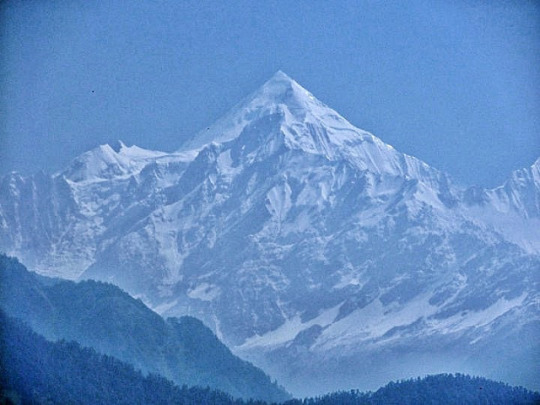
View of the Panchachulli from Munsiyari in Kumaon
The Kumaon division rises sharply from the sub Siwalik (foothills) strip of land to the high snowy peaks with glaciers. The outer ranges of the Himalaya, a part of which is known as Gagar ranges, rises quickly from submontane tracts to 7000-8000 ft, where many of the famous hill stations, such as, Mussorie, Nainital, Almora, Lansdowne, etc., are situated. This part is especially beautiful with its densely forested parts; and when standing at the tops of peaks that often reach more than 8000 ft, the view is spectacular with plains visible on the southern side, and the endless waves of entangled northern ridges on the other side that is bordered in the horizon by beautiful snow peaks of the central axis of the Himalaya. The outer ranges of the Himalaya hold some beautiful low altitude Himalayan lakes, such as, Nainital, Bhimtal, Sattal, Naukuchiatal, Malwa tal, and Khurpa tal. It is believed that most of these low altitude lakes were formed by tectonic movements that blocked rivers during the Holocene period.

Almora town

Spectacular views from the Gagar ranges (Nainital): endless waves of entangled northern ridges bordered by snowy peaks of the central axis of the Himalaya in the horizon. (photo courtesy: Atanu Dey)

Nainital. A low altitude Himalayan lake in the outer ranges (Gagar ranges). (photo courtesy: Atanu Dey)

Khurpa tal. Another low altitude Himalayan lake in the outer ranges (Gagar ranges) near Nainital. (photo courtesy: Atanu Dey)

Bhim tal. Another low altitude Himalayan lake in the outer ranges (Gagar ranges) near Nainital.
The Bhabar, a strip of land with gently sloping mass that contains mainly riverine debris (coarse gravels), is just below the hilly tract. It is here that the mountain streams descending from the outer ranges and Siwalik hills lose their flow amidst strewn boulders, and re-appear only during the monsoons. It is forested (sal), with many of the forests now having given way to cultivated areas. The rest of the foothills are known as Tarai grassland region, which is primarily moist plain land with the Tarai springs that keep the area perennially hydrated and fertile. Tarai vegetation is characterised by tracts of clayey swamp (Gangetic alluvium), tall grasslands, deciduous forests, and scrub savannah. The three main rivers in Kumaon division are the Kosi, Gola, and Nandhaur. The Kosi river (or Kaushiki, as named in Skandapurana) starts from Dharapani in Almora district, while the Gola and Nandhaur arise from somewhere in the southern slopes of the outer hills. All the three rivers, and other smaller streams in the Bhabar and Tarai areas all drain into the Ramganga. The other major river on the Nepal-Kumaon border is the Sharda river (also known as the Kali Ganga or Maha Kali) that descends from the Kalapani territory, and joins the Ghaghra/Karnali river in the state of Uttar Pradesh.

Kosi River, Jim Corbett National Park, Ramnagar- Almora district (Photo from Wikipedia)
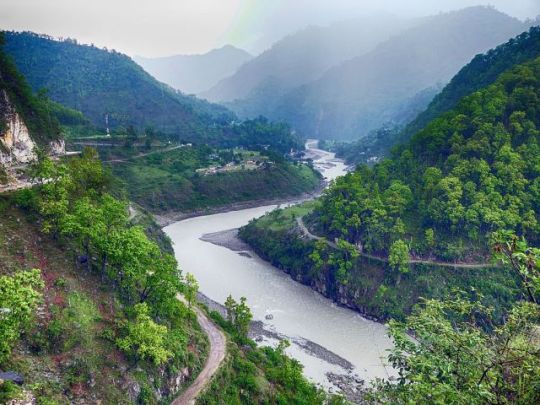
Sharda or Mahakali River near Jauljibi in Pithoragarh district of Kumaon (photo source: Wikipedia
The lower sub-Himalayan ranges show Upper Tertiary era deposits of Nahan sandstone, while the higher ranges are made of older slate, quartzite, dark dolomite or limestone, and other schistose and granite rocks. Owing to the heavy rainfalls experienced in these areas the steep slopes often give way to massive landslides. Kumaon, which is situated on the southern slope of the Himalayan range, show great variations in climate and vegetation that change drastically with changes in elevation, ranging from glaciers at its highest elevations, to subtropical forests at the lower elevations, to grasslands at the flat lands on foothills. While travelling in car these changes are clearly visible, as one moves from the lowlands of Terai that show mostly grasslands, and Bhabar with its remaining pockets of sal forests; to the higher hills that are filled with coniferous and broad-leaf forests, alpine shrubs, and meadows; and finally to the snowy peaks of the Upper Himalaya.

Sunrise from behind the snowy peaks of the Panchachulli range, Kumaon
Origin of the name Kumaon
A look at the history of this area shows that the SkandaPurana (Manash Khanda) refers to this part as Kurmavana or Kumaravana; and it is believed that the word Kumaon is a corruption of the original Puranic term. According to folklore, Vishnu had reincarnated here in Kumaun (near Lohaghat) as Kurma (his second incarnation), to support the Mandar mountain during samudramanthan.


Kurma Avatar of Vishnu, below Mount Mandara, with Vasuki wrapped around the mountain, during Samudra Manthan. ca 1870. (Photo from Wikipedia)
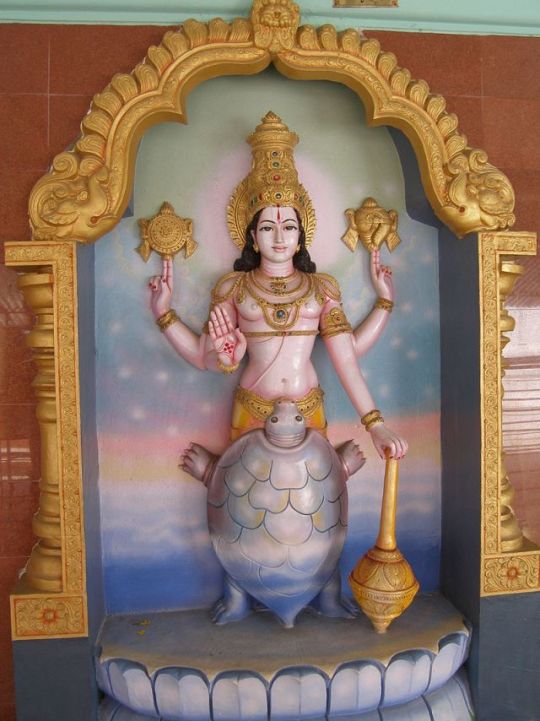
Kurmavatara of Lord Vishnu at Narayana Tirumala (Photo from Wikipedia). Kurma in the Vedic texts symbolises the importance of basic principles and the support necessary for any long term creative activity. In Shatapatha Brahmana (6.1.1 and 7.5.1) Kurma’s shape represents the hemispherical shape (assumed) of the earth, and it is for this reason kurma shape is one among the Vedic fire altar designs.
According to Kumaoni folklore, Vishnu in his kurma avataar stood here for three years on the Kurma-mountain (Kandadeva or Kandeva), which is on the east of the river Champavat, and marks of the tortoise’s feet still remain as imprints. It is for this reason that the region came to be known as Kurma + achal or Kurmachal, which got morphed into Kumu, and later to Kumaon. Initially only the areas around river Champavat were known as Kumaon, but later the whole pargana of Kali Kumaon that comprised of villages along the Kali river came to be known as Kumaon. Later during the reign of Chand dynasty, the entire region, which included the districts of Nainital and Almora, was renamed as Kurmachal or Kumaun. During British rule the Dehradun district also was included in Kumaun.
It was the Chand dynasty rulers who made the term Kurmachal or Kumaon widely popular in this hill state, and prior to their reign there are no mentions of Kurmachal or Kumaon in any of the inscriptions found. The Chands used Kurmachal in all their records. Under their rule that lasted from 11th c. CE to 1815 CE, there were three administrative divisions in Kurmachal:
(i) Kali Kumaun, (ii) Almora, and (iii) Tarai Bhawar or Mal.
Interestingly, while most believe that the term Kurmachal was derived from Kurma, Thakur Jodh Singh Negi in his Himalayan Bhraman had opined that as the people of Kumaon were expert farmers and also quite wealthy, so this region came to be known as Kumaon, derived from the local dialect kumuno, which means a cultivated land. He further theorised that the region Kali Kumaon was named not after the river Kali but after Kalu Tadagi who had once ruled the area, and owing to the presence of thick black bushes of fir and banjha, the adjective ‘Kali’ got added to it. While these theories may provide some interesting viewpoints, they are certainly not based on any historical evidences. Linguistically too, Kumaon as a derivation from Kurmachal appears more logical.
Currently Almora, Bageshwar, Champawat, Nainital, Pithoragarh, and Udham Singh Nagar form the Kumaun division; however, linguistically Kumaon can be further sub divided. Thus, we find that Kali (or Central) Kumaoni dialect is spoken in Almora and northern Nainital, while North-eastern Kumaoni dialect is used in Pithoragarh. South-eastern Kumaoni is spoken in South-eastern Nainital, and Western Kumaoni is spoken west of Almora and Nainital.
While originally the people of Kali Kumaoni were the only Kumaonis, with the Nainital and Almora people being later additions; yet the people from Gangoli and Chaugarkha that are parts of Kali Kumaon, are not termed as Kumaonis, but are called Gangolas and Chaugarikhiyas.
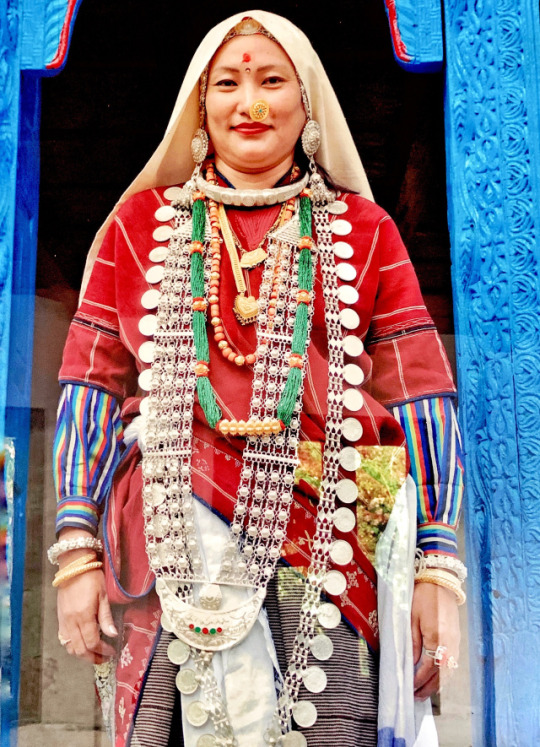
A Kumoani woman in full traditional attire and jewellery (photo from KMVN – Binsar). The common daily wear is now of course a saree, for more practical reasons suitable for a working woman.
Kumaon history
The archaeology based history of the region remained sketchy for quite some time owing to disjointed facts and sporadic records that were available until the 19th century CE. In terms of literary history, the region finds many fleeting references in the epics and the Puranas. Mahabharata mentions this area frequently, especially where it talks of the Kiratas who lived near the sources of the Ganga and Yamuna. The Khasas or Khasias come next, who are found mentioned in the Mahabharata as living in the same areas as the Kiratas. Pliny mentioned Casiri, which many historians identify as the Khasias. Herodotus also mentioned of people living in this area as “Indians who lived in the city of Kaspatyrus.” Ptolemy had written about a group of people living in this area, which Cunningham studied extensively and identified them with the Kulindas of Mahabharata. The Yaudheyas (5th c. BCE – 4th c. CE), a military confederation, had also ruled this area at some point of time, as evident from the coins found. The Kalsi rock edicts of Ashoka (260 – 230 BCE), discovered by Alexander Cunningham in 1850, are important pieces of archaeological evidences that mention the people living in this region.

Edict No13 of Ashoka, Khalsi inscription, with the identification of Hellenistic kings Antiochos II, Ptolemy II, Antigonos II Gonatas, Magas of Cyrene and Alexander II of Epirus. these edicts were found in Khalsi in Dehradun district. (photo from Wikipedia)

The Kalsi inscriptions are now housed in this room and maintained by the ASI. (photo from the internet). Kalsi is a small town located between Chakrata and Dehradun near Dakpatthar on the banks of Yamuna. The inscriptions found here are important as these are the only Ashokan edicts found in the hill states of north India. The edicts are written in Pali.
It is believed by D. R. Bhandarkar that the Khasas were the first to settle in the hilly tract of Uttarakhand, followed by the Gurjaras who came in after 6th c. CE and took over Sapadlaksha (the area around Shivalik ranges stretching from Hoshiyarpur -Punjab to Kumaon), and it is from here that the Gurjaras later moved down to what is now the state of Rajasthan.
ET Atkinson had done some extensive researches on the available cultural, social, and historical data of the area, and had recorded it in his pioneering work titled “Himalayan Districts of the North-Western provinces of India,” published in 1884. Later discoveries and studies of the various inscriptions such as the Jageswar inscriptions, Lakhamandal inscriptions, the two Talesvara Copper Plate, and Pandukesvar inscriptions have given some significant insights into the 6th-7th CE history of the area. There are many more such later period research works on this arena by Rahul Sankrityayan, H.K. Raturi, S.P. Dabral, and B.D. Pande.
Much later, extensive studies of fossil remains found from rocks in this region that date back to 18.3 to 0.6 million years BP have opened up a vista of the prehistoric era as had existed here. The fossil studies have revealed “a variety of Stresirhine Primate genera, Cercopithecoid genera, and Hominoid genera, the last one being of special interest to hominid ancestry. Significantly, Kalagarh Basin (District Pauri, Uttarakhand) has also witnessed Hominoid activities some 11 to 10 million years ago. These include Sivapithecus indicus and Ramapithecus punjabicus. These hominoids form important links in the evolution of hominids” (Archaeological Survey of India, Dehradun circle). Furthermore, the recent discoveries of “Palaeolithic era tools from Potwar (northern Pakistan) dated between 2.4 and 2.0 million years BP, and from Uttarbaini (Jammu and Kashmir, India) dated between 2.5n and 0-5 million years BP” have given rise to the theory that the Himalayan region could have been the cradle of the earliest hominids of the world.
Recent archaeological studies of this region have given an insight into the different technological stages of human evolution ranging from the Stone to Copper, and Iron Ages (pre-and protohistoric periods). Meanwhile the historical studies from different numismatic, literary, and epigraphical evidences, give us the names of some of the important dynasties that have ruled this area. These include the Kunindas (2nd BCE to 4th c. CE); while in the 4th CE we find that the area was known as Karttripura kingdom, a vassal kingdom under the Guptas (as written in Samudra Gupta’s Parayaga Prasasti).
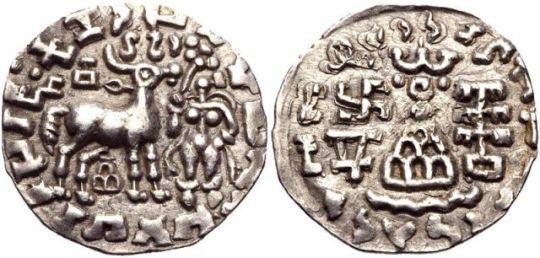
Silver coin of the Kuninda Kingdom, c. 1st century BCE.
(photo from Wikipedia)
From the Talesvara Copper Plate Inscriptions of Almora we find that this region was called Brahmapura in the 6th-7th c. CE, during the reign of the Paurava-Varmans. The name Brahmapura is found in the Vrihatsamhita, while Heiun Tsang also mentions it in his 7th c. CE travel book (he writes it as as Po-lo-hi-mo-pu-lo, that in Sanskrit translates to Brahmapura). The kingdom of Brahmapura declined by the end of 8th c. CE, and next came the Katyuris, who ruled from 9th -12th c. CE. From various inscriptions it is clear that some parts of this area came under the dominion of the Mallas of Nepal from 1191 CE to 1223 CE, and that effectively ended the Katyuri rule, though later inscriptions show that the Katyuris survived as petty rulers of smaller areas. After the Katyuris, eventually from 11th century onward emerged the most powerful dynasty of Kumaon, the Chand dynasty, who kept control until 1815. The British conquered it in 1815 and took over the area, which remained with them until 1947.
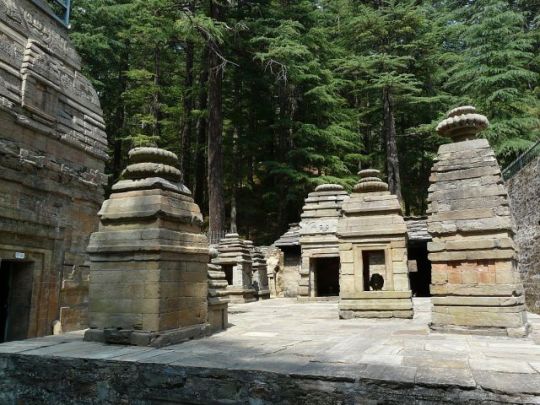
Katarmal sun temple built by the Katyuris in 9th c.CE

Bineswara temple built by the Chand dynasty in 16th c. CE

Jageswara temple cluster. Built between 7th to 12th CE, with renovations going up to 17th century under the Chand dynasty
References
Pande, B. D. History of Kumaon: English version of “Kumaon ka itihas”. Almora, U.P., India: Shyam Prakashan: Shree Almora Book Depot, 1993.
Omacanda Hāṇḍā, History of Uttaranchal. Indus Publishing, 2002.
Kanti Prasad Nautiyal, The Archaeological of Kumaon, 1969.
Alexander Cunningham, Archaeological Survey Report, vol. II.
Bhandarkar, D. R. Gurjaras (Art.), J B B R S, Vol. XXI,1903.
Hermann Goetz, Studies in the History and Arts of Kashmir and the Indian Himalayas, Weisbaden, 1969.
Archaeological Survey of India, Dehradun circle –https://www.asidehraduncircle.in/uttarakhand.html
Kurmachal or Kumaun – The land of Vishnu माटू हमरू, पाणी हमरू, हमरा ही छन यी बौण भी... पितरों न लगाई बौण
#almora#art#binsar#chanddynasty#culture#explorer#hinduism#history#jageswara#katarmal#katyuris#mountains#nainital#people#photography#religion#travel#Uttarakhand#Uttaranchal#uttarpradesh
0 notes
Text
Nepal Bangladesh Bank Ltd.

Nepal Bangladesh Bank Ltd. is a leading ‘A’ class commercial bank licensed by Nepal Rastra Bank. Nepal Bangladesh Bank was registered with Office of Company Registrar (50-050/051, Dated January 14, 1994) as a public company limited by shares. Nepal Bangladesh Bank started its banking operation from 6th June, 1994. Nepal Bangladesh Bank was established as a joint venture bank with IFIC Bank Ltd., Bangladesh. Shares of the bank are listed in Nepal Stock Exchange Ltd. since 1995.
Vision
The bank for everyone
Mission of Nepal Bangladesh Bank
To offer financial services and become the “bank for everyone" by dedicating the progress and growth of the bank to the community, customers, employees and stockholders by:
Fulfilling financial expectation of all level of society
Providing excellent customer services by offering personalized quality services and products
Giving reasonable returns to all related stakeholders
Using the latest technology aimed at customer satisfaction & act as an effective catalyst for socio-economic developments
Maintaining high standard corporate governance in all levels
Core Values and Code of Conduct/Ethical Principles
The Bank has defined following core values for achieving the vision and mission:
Deliver quality and complete financial services
Provide value to the stakeholders
Be accountable for delivering what we promise
Demonstrate honesty and integrity in all actions
Be balanced in customer orientation and risk consciousness
Be efficient and technology oriented
Overall Strategic Objectives of Nepal Bangladesh Bank
Stick on core values and code of conduct for betterment of the bank
Branches Inside Valley
S.no.
Branch Name
Province
Province District
Local Bodies
Local Body Ward
Branch Manager
Phone Number
Branch Email
1
CORPORATE
3
Kathmandu
Kathmandu Metroplitian City
28
Rajendra Prasad Adhikari
01-4233780/81/82/83/84/85
[email protected]
2
NEWROAD
3
Kathmandu
Kathmandu Metroplitian City
22
Santosh Bhattarai
01-4224477/ 4241368
[email protected]
3
BAHAINSEPATI
3
Lalitpur
Lalitpur Metropilitian City
25
Meen Bahadur Rawal
01-5592630/ 5590028
[email protected]
4
MAIN
3
Kathmandu
Kathmandu Metroplitian City
10
Ujjwal Bajracharya
01-4780770/ 4782767/ 4781195
[email protected]
5
KALIMATI
3
Kathmandu
Kathmandu Metroplitian City
13
Pradeep Poudel
01-4277298/ 4284936
[email protected]
6
LALITPUR
3
Lalitpur
Lalitpur Metropilitian City
5
Binod Ranjit
01-5554011/ 5008721
[email protected]
7
BHAKTAPUR
3
Bhaktapur
Surya Binayak Municipality
5
Usha Dhungel
01-6613170
[email protected]
8
KAPAN
3
Kathmandu
Kathmandu Metroplitian City
10
Sanjeeb Sharma
01-4823335
[email protected]
9
BALAJU
3
Kathmandu
Kathmandu Metroplitian City
16
Harish Shrestha
01-4383768/ 4384170
[email protected]
10
JORPATI
3
Kathmandu
Gokarneshwor Municipality
5
Nabin Prasad Shrestha
01-4910997/ 4910828
[email protected]
11
KIRTIPUR
3
Kathmandu
Kirtipur Municipality
1
Rabin Shakya
01-5195123/ 5195348
[email protected]
12
IMADOLE
3
Lalitpur
Mahalaxmi Municipality
1
Rekha Pradhan
01-5204202
[email protected]
13
MAHARAJGUNJ
3
Kathmandu
Kathmandu Metroplitian City
3
Krishna hari Bhandari
01-4376565/ 4376525
[email protected]
14
CHABAHIL
3
Kathmandu
Kathmandu Metroplitian City
7
Anjana Pandey Lohani
01-4482692/ 4483386
[email protected]
15
KOTESHWOR
3
Kathmandu
Kathmandu Metroplitian City
32
Bisho Rup Khadka
01-4600219
[email protected]
16
MAITIDEVI
3
Kathmandu
Kathmandu Metroplitian City
30
Santosh Kumar Trital
01-4440335, 01-4440336
[email protected]
17
SANEPA
3
Lalitpur
Lalitpur Metropilitian City
2
Amrit Lal Shrestha
01-5546010/11
[email protected]
18
TOKHA
3
Kathmandu
Kathmandu Metroplitian City
7
Shree Ram Nepal
01-4355345/01-4381150
[email protected]
Branches Outside Valley
S.no.
Branch Name
Province
Province District
Local Bodies
Local Body Ward
Branch Manager
Phone Number
Branch Email
1
BATTAR
3
Nuwakot
Bidur Municipality
4
Rajendra Prasad Dhakal
010-561776/ 560256
[email protected]
2
JANAKPUR
2
Dhanusha
Janakpur Sub Metropolitian City
2
Ravi Bhatta
041-523385/ 521548
[email protected]
3
BUTWAL
5
Rupendehi
Butwal Sub Metropolitian City
6
Anjan Koirala
071-544845/ 544906
[email protected]
4
HETAUDA
3
Makwanpur
Hetauda Sub Metropolitian City
10
Ram Kumar Shrestha
057-523034/ 524936
[email protected]
5
BIRGUNJ
2
Parsa
Birgunj Sub Metropolitian City
4
Sagendra Bhakta Pradhananga
051-523689/ 523494
[email protected]
6
NEPALGUNJ
5
Banke
Nepalgunj Sub Metropolitian City
11
Keshab Gautam
081-415135
[email protected]
7
BIRATNAGAR
1
Morang
Biratnagar Metropolitian City
9
Balkrishna Shrestha
021-530523/ 524263
[email protected]
8
BARAHBISE
3
Sindhupalchowk
Barahbise Municipality
8
Shree Krishna Paudel
011-489022
[email protected]
9
DHANGADHI
7
Kailali
Dhangadhi Sub Metropolitian City
2
Sushil Bahadur Singh
091-521785
[email protected]
10
POKHARA
4 (Gandaki Pradesh)
Kaski
Pokhara Lekhnath Metropolitian City
9
Devendra Awasthy
061-533134/ 533135
[email protected]
11
DHARAN
1
Sunsari
Dharan Sub Metropolitian City
12
Saroj Babu Tiwari
025-530166
[email protected]
12
DHUNCHE
3
Rasuwa
Gosaikunda Rural Municipality
6
Roshan Kumar Rajkarnikar
010-540015
[email protected]
13
NARAYANGADH
3
Chitawan
Bharatpur Metro
3
Kiran Kumar Pradhan
056-570962/ 5709631
[email protected]
14
BHOJPUR
1
Bhojpur
Bhojpur Municipality
5
Abishekh Adhikari
029-420713
[email protected]
15
BIRTAMODE
1
Jhapa
Bitramod Municipality
5
Shyam Kumar Rijal
023-545724/ 545744
[email protected]
16
BHAIRAHAWA
5
Rupendehi
Siddharthanagar Municipality
7
Bishnu Raj Rayamajhi
071-521658/ 521659
[email protected]
17
SALYAN
6 (Karnali Pradesh)
Salyan
Sharada Municipality
1
Prakash Neupane
088-400182
[email protected]
18
SURKHET
6 (Karnali Pradesh)
Surkhet
Birendranagar Municipality
6
Ratna Kala Rawal
083-520220/ 521481
[email protected]
19
DARCHULA
7
Darchula
Mahakali Municipality
4
Shyam Raj Badu
093-420242
[email protected]
20
SANKRANTI
1
Terahthum
Aatharai Rural Municipality
4
Bharat Bharati
026-680966/ 680967
[email protected]
21
DANG
5
Dang Deokhuri
Ghorahi Sub Metro
15
Prakash Ghimire
082-563796/7
[email protected]
22
BIRATCHOWK
1
Morang
Sundar Haraicha Municipality
10
Sujan Timsina
021-545799/ 545789
[email protected]
23
KARSIA
1
Morang
Dhanpalthan Rural Municipality
4
Amit Bastola
021-565038
[email protected]
24
GALCHHI
3
Dhading
Galchhi Rural Municipality
6
Sunil GC
010-403127
[email protected]
25
JHALARI
7
Kanchanpur
Suklaphata Municipality
10
Tilak Raj Bhatta
099-540067
[email protected]
26
MUSIKOT
6 (Karnali Pradesh)
Rukum (Paschim)
Musikot Municipality
1
Kranti Kumar Sapkota
088-530364
[email protected]
27
PHIDIM
1
Panchthar
Phidim Municipality
1
Raj Kumar Thapa
024-521081
[email protected]
28
KHAIRENI
3
Chitawan
Khairahani Muncipality
1
Binod Dhital
056-583097
[email protected]
29
CHAINPUR
7
Bajang
Jaya Prithvi Municipality
8
Bhim Raj Pokharel
091-4211431
[email protected]
30
KUSHMA BAZAR
4 (Gandaki Pradesh)
Parbat
Kushma Municipality
6
Hemant Pant
067-421327
[email protected]
31
KHAJURA
5
Banke
Khajura Rural Municipality
3
Chandra Bahadur Shrestha
081-560428/ 560429
[email protected]
32
LEKHNATH
4 (Gandaki Pradesh)
Kaski
Pokhara Lekhnath Municpality
3
Barsha Shrestha
061-411445
[email protected]
33
BAGLUNG
4 (Gandaki Pradesh)
Baglung
Baglung Municipality
2
Ishwori Prasad Pokharel
068-520310/ 522872
[email protected]
34
DALDALE
4 (Gandaki Pradesh)
Nawalpur
Devchuli Municipality
13
Puspa Ram Mahato
078-575570
[email protected]
35
ITAHARI
1
Sunsari
Itahari Sub Metro
1
Krishna Timsina
025-582411
[email protected]
36
SINDHUWA
1
Dhankuta
Chhathar Jorpati Rural Municipality
6
Tanka Prasad Limbu
026-404169
[email protected]
37
SINZA
6 (Karnali Pradesh)
Jumla
Sinja Rural Municipality
3
Tula raj Shahi
9758004548
[email protected]
38
SANGURIGADI
1
Dhankuta
Sangurigadhi Rural Municipality
6
Nirajan Dhungana
025-400078
[email protected]
39
CHHATHAR
1
Terahthum
Chhathar Rural Municipality
7
Sudeep Dhakal
9851142173
[email protected]
40
PANCHKHAPAN
1
Sankhuwashava
Panchakhapan Municipality
6
Suresh Budhatoki
029-411084
[email protected]
41
CHHATARGUNJ
5
Argakhanchi
Chhatradev Rural Municipality
5
Bijay Thapa
077-690436
[email protected]
42
BHUMLU
3
Kavre
Bhumlu Rural Municipality
5
Sarada Prasad Bhattrai
9741473634
[email protected]
43
SALPASILICHO
1
Bhojpur
Salpasilicho Rural Municipality
3
Durga Bahadur Kafle
9842306473
[email protected]
44
BARDIBAS
2
Mahottari
Bardibas Municipality
1
Diwakar Lal Karna
044-550154
[email protected]
45
BRAHMAPURI
2
Sarlahi
Brahmapuri Rural Municipality
2 "Kha"
Sujan Khanal
9851067147
[email protected]
46
KOUDENA
2
Sarlahi
Koudena Rural Municipality
2
Ram Babu Thapa
9854035716
[email protected]
47
CHANDRANIGAHAPUR
2
Routahat
Chandrapur Municipality
5
Lil Bahadur Rokaha
055-540670/72
[email protected]
48
SIMARA
2
Bara
Jitpur Simara Sub Metroplitian
2
Satish Maharjan
053-520627/053-520628
[email protected]
49
PARWANIPUR
2
Bara
Parwanipur Rural Municipality
4
Sanjay Kumar Yadav
051-410069/ 051-410069
[email protected]
50
HAPURE
5
Dang
Babai Rural Municipality
4
Mr. Swadhin Singh Basnet
082-403056/ 082-403057
[email protected]
51
MAKWANPURGADHI
3
Makwanpur
Makwanpurgadhi Rural Municipality
3
Dilli Bahadur Karki
9849656094
[email protected]
52
CHANDRAUTA
5
Kapilbastu
Shivaraj Municipality
5
Khem Raj Bhattarai
076-540526
[email protected]
53
BISHNU
2
Sarlahi
Bishnu Rural Municipality
6
Biswanath Yadav
9844037325
[email protected]
54
DHANAUJI
2
Dhanusha
Dhanauji Rural Municipality
2
Pradeep Kumar Thakur
9813094594
[email protected]
55
ARNAMA
2
Siraha
Arnama Rural Municipality
3
Krishna Kumar Shah
9852020660
[email protected]
56
RAJARANI
1
Dhankuta
Chaubise Rural Municipality
6
Ghanashyam Basnet
026-411062
[email protected]
57
FIKKAL
1
Ilam
Suryodaya Municipality
10
Milan Karki
027-540595
[email protected]
58
CHANDRANAGAR
2
Sarlahi
Chandranagar Rural Municipality
3 "Ka"
Deb Sharan Raut
9861905813
[email protected]
59
DEWAHI GONAHI
2
Rautahat
Dehawi Gonahi Rural Municipality
8
Diwas Sarraph
9845428941
[email protected]
60
DAMOULI
4 (Gandaki Pradesh)
Tanahun
Byas Municipality
4
Suman Subedi
065-560880/065-560881
[email protected]
61
SANDHIKHARKA
5
Argakhanchi
Sandhikharka Municipality
1
Sagar Kunwar
077-420965
[email protected]
62
CHANDEV
7
Kanchanpur
Laljhadi Rural Municipality
6
Pankaj Bhatt
9848751003
[email protected]
63
FEDAP
1
Terahthum
Fedap Rural Municipality
1
Rochak Kathet
026-681031/026-681032
[email protected]
64
BULINGTAR
4 (Gandaki Pradesh)
Nawalpur
Bulingtar Rural Municipality
3
Dhurba Raj Pokhrel
9851170643
[email protected]
65
KALIMATI (RAMPUR)
6 (Karnali Pradesh)
Salyan
Kalimati Rural Municipality
3
Min Raj Adhikari
9849180380
[email protected]
66
TIMURE
3
Rasuwa
Gosaikunda Rural Municipality
9
Anup Bhujel
010-543022
[email protected]
67
MAHENDRANAGAR
7
Kanchanpur
Bhimdutta Municipality
4
Bed Prakash Badu
099-522112/099-522168
[email protected]
68
TIKAPUR
7
Kailali
Tikapur Municipality
1
Deepak Khadka
091-560752/ 091-560362
[email protected]
69
KOHALPUR
5
Banke
Kohalpur Municipality
11
Padam Raj Upreti
081-540256 /081-540258
[email protected]
70
DAMAK
1
Jhapa
Damak Municipality
6
Krishna Kumar Adhikari
023-580163/023-580164
[email protected]
71
MIRCHAIYA
2
Siraha
Mirchaiya Municipality
Ajit Kumar Jha
9854035716
[email protected]
72
Malangwa
2
Sarlahi
Malangwa Municipality
6
Ritesh Kumar Sah
046-521705/06
[email protected]
List of Extension Counter of Nepal Bangladesh Bank Ltd
S.N.
Counter Name
District
Municipality
Ward
Tole
Phone No.
Related Branch
1
TATOPANI CUSTOM
SINDHUPALCHWOK
3
CUSTOM OFFICE
……..
BAHRABISE BRANCH
2
TIMMURE
RASHUWA
..
TIMMURE
16-923534
DHUNCHE BRANCH
3
ICAN
LALITPUR
15
SATDOBATO, ICAN Building
LALITPUR BRANCH
4
MID WESTERN UNIVERISITY
SURKHET
SURKHET, Mid Western University Office
SURKHET BRANCH
5
NOC (Nepal Oil Corporation)
BARA
AMLEKHGUNJ, NOC Office
HETAUDA BRANCH
6
Chanauli Extension Counter
CHITAWAN
CHANAULI MALPOT OFFICE
9802092740
NARAYANGADH BRANCH
7
Sindhuwa Extension Counter
DHANKUTA
2
Chathar Jorpati Gaupaika Office
9842170332
SINDHUWA BRANCH
Branchless Banking (BLB) Outlets of Nepal Bangladesh Bank Ltd
S.N.
BLB Location
District
Municapality
Ward
Tole
Mobile Number
BLB Agent
Related Branch
1
RAMKOT
Kathmandu
Nagarjun Municipality
7
Ramkot
9841904693
Bhaskar Gautam
KALIMATI BRANCH
2
KHOKANA
Lalitpur
Lalitpur Metro
21
Khokana
01-5592126/ 9841552801
Hari Ram Dangol
BHAISEPATI BRANCH
List of ATM Counter Inside Kathmandu Valley
S.N.
District
BRANCH
VDC/Municipality
Location
1
Kathmandu
Chabahil
Kathmandu Metro
Mitra Park
2
Bhaktapur
Bhaktpur
Surya Binayak Municipality
Sallaghari
3
Kathmandu
Main Branch
Kathmandu Metro
Bijuli bazaar
4
Lalitpur
Imadol
Mahalaxmi Municipality
Imadole
5
Kathmandu
Main Branch
Kathmandu Metro
Battisputali
6
Kathmandu
Kalimati
Kathmandu Metro
Kalimati ,Chandi Complex
7
Kathmandu
Corporate
Kathmandu Metro
Lazimpat (Big Mart)
8
Lalitpur
Bhaisepati
Lalitpur Metro
Sainbu
9
Kathmandu
Balaju
Kathmandu Metro
Naya Bazar
10
Kathmandu
Kapan
Budanilkantha Municipality
Akasdhara
11
Kathmandu
Newroad
Kathmandu Metro
Meera Home Khichapokhari
12
Bhaktapur
Bhaktpur
Bhaktapur Municipality
Cancer Hospital ,Bhaktapur
13
Kathmandu
Jorpati
Gokarneshwor Municipality
Jorpati
14
Lalitpur
Lalitpur
Lalitpur Metro
Kumaripati
15
Kathmandu
Corporate
Kathmandu Metro
Gyaneswor (Jain Bhawan)
16
Kathmandu
Corporate
Kathmandu Metro
Kamaladi (Corporate Building)
17
Kathmandu
Kirtipur
Kirtipur Municipality
Tyanglaphat
18
Kathmandu
Maharajgunj
Kathmandu Metro
Maharajgunj
19
Kathmandu
Balaju
Kathmandu Metro
Thamel
20
Kathmandu
Newroad
Kathmandu Metro
Newroad (Jhonse)
21
Kathmandu
Koteshwor
Kathmandu Metro
Koteshwor
22
Lalitpur
Lalitpur
Lalitpur Metro
ICAN Building Satdobato
23
Kathmandu
Corporate
Kathmandu Metro
Kamaladi (Corporate Building)
24
Kathmandu
Corporate
Kathmandu Metro
Kamaladi (Corporate Building)
25
Kathmandu
Corporate
Kathmandu Metro
Seto Pool, Maitidevi
Outside Kathmandu Valley
S.N.
District
BRANCH
VDC/Municipality
Location
1
Nuwakot
Battar
Bidur Municipality
Battar Bazaar
2
Bhojpur
Bhojpur
Bhojpur Municipality
Bhojpur Bazar
3
Banke
Nepalgunj
Nepalgunj Sub Metro
Dhamboji, Surkhet Road
4
Kaski
Pokhara
Pokhara Lekhnath Metro
Ramghat (Hospital Chowk)
5
Makawanpur
Hetauda
Hetauda Sub Metro
Rapti Road
6
Sunsari
Dharan
Dharan Sub Metro
Mahendra Path
7
Rupandehi
Bhairahawa
Siddharthanagar Municipality
Siddharthanagar
8
Rasuwa
Rasuwa
Gosaikunda Rural Municipality
Dhunche
9
Kaski
Pokhara
Pokhara Lekhnath Metro
Chipledhunga
10
Morang
Biratnagar
Biratnagar Metro
Rangeli Road
11
Chitawan
Narayangarh
Bharatpur Metro
Pulchowk, Narayangarh
12
Parsa
Birgunj
Birjung Metro
Alkhiya Road
13
Surkhet
Surkhet
Birendranagar Municipality
Hulak Chowk
14
Nuwakot
Battar
Bidur Municipality
Trishuli
15
Rupandehi
Butwal
Butwal Sub Metro
Traffic Chowk
16
Dhanusha
Janakpur
Janakpur Sub Metro
Bhanu Chowk
17
Kailali
Dhangadi
Dhangadi Sub Metro
Chauraha, Main Road
18
Morang
Biratchowk
Sundar Haraicha Municipality
Biratchowk
19
Jhapa
Birtamod
Bitramod Municipality
Jhapa
20
Kanchanpur
Jhalari
Suklaphata Municipality
Kanchanpur
21
Panchthar
Phidim
Phidim Municipality
Panchthar
22
Chitwan
Khairahani
Khairahani Muncipality
Chitwan
23
Prabat
Kushma
Kushma Municipality
Parbat
24
Salyan
Salyan
Sharada Municipality
Shreenagar
25
Banke
Khajura
Khajura Rural Municipality
Khajura
26
Bara
Hetauda
Amlekhgunj
Amlekhgunj
27
Kaski
Lekhnath
Pokhara Lekhnath Metro
Lekhnath
28
Baglung
Baglung
Baglung Municipality
Jeep Park
29
Nawalparari
Daldale
Devchili Municipality
Daldale
30
Sunsari
Itahari
Itahari Sub Metor
Itahari
31
Dhankuta
Sindhuwa
Chhathar Jorpati Rural Municipality
Sindhuwa
32
Dhankuta
Sangurigadhi
Sangurigadhi Rural Municipality
Bhedetar
33
Bradibas
Bardibas
Bardibas Municipality
Bardibas
34
Bara
Simara
Jitpur Simara Sub-Metropolitan City
Simara
35
Dang
Dang
Ghorahi Sub-Metropolitan City
Ghorahi
36
Ilam
Fikkal
Suryodaya Municipality
Fikkal Bazar
37
Tahanu
Damauli
Byas Municipality
Damauli Bazar
38
Arghakhanchi
Sandhikharka
Sandhikharka Municipality
Sandhikharka
Read the full article
0 notes
Text
Landslide Hazard Analysis by Using Arc GIS and Google Earth: A Case Study of Province 5, Nepal - Juniper Publishers
Journal of Trends in Technical and Scientific Research
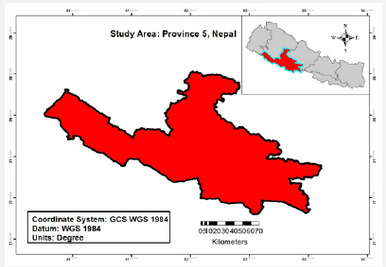
Abstract
Province 5 of Nepal is one of the vulnerable province to natural and human induced disasters like landslides. This research was objectively carried out to estimate the number and area of the landslide and find out the district, municipality and rural municipality wise spatial distribution of landslides in the study area. The visible scars of landslides were located and outlined in Google Earth™ and further analyzed in ArcGIS 10.3. Altogether, 701 landslides were found in 12 districts with total area coverage of 1940.17 ha. The largest area cover of landslide was found in Dang district with 326.99 ha and the lowest area cover of landslide of 8.63 ha was calculated in Rupandehi district. The highest occurrence 44 landslides occurred in Naubahini Rural Municipality of Pyuthan district followed by Sandhikharka municipality of Arghakhanchi district and Ghorahi sub-metropolitan city of Dang district with 43 and 42 landslides respectively. In Bardiya district, Bardia National park had 57 landslides instances on area of 260.62 ha. The highest area covered by landslides was 191.36 ha in Bijayanagar Rural Municipality of Kapilbastu district, 119.14 ha in Lamahi Municipality of Dang district, 106.66 ha in Sunwal Municipality of Nawalparasi district and 102.9 ha in Putha Uttarganga Rural Municipality of Rukum East district. Overall, this research depicts landslide area of whole province 5 and will be helpful to assist in further decision making. This type of the study can be very useful without much fieldwork and saves huge amount of time and money.
Keywords: Spatial distribution Google Earth™ Arc GIS Landslides
Introduction
Province 5 is one of the seven provinces established by the new constitution of Nepal. This province does not have an official database for landslides. Landslides, defined as the mass movement of rock, debris or earth down a slope [1], can be triggered by various external stimuli. Landslides are geologic hazards that occur on spatial and temporal scales in mountainous landscapes and are frequently responsible for considerable loss of life and property [2]. As one of the major natural hazards, landslides claim people’s lives almost every year and cause huge property damage in mountainous areas [3,4]. The characteristics of various types of landslides are important to develop appropriate mitigation measures in the mountainous terrain of Nepal because the problems of landslides are different in different physiographic, geologic and climatic zones [5]. The inherently weak geological characteristics of rocks and soils have made the Himalaya fundamentally a very fragile mountain [5] and the triggering factors such as rainfall and earthquakes play their role to make the mountain very vulnerable to landslides and other mass wasting processes. The Midland areas have been highly susceptible to landslide due to complex interaction of natural and man-made factors [6]. Precambrian to Cambrian Lesser Himalayan met sedimentary zone of western Nepal is one of the vulnerable zones among morpho-tectonic units of Nepal due to its rugged mountain topography,complex and fragile nature of the geological formations, active groundwater activities, soft soil cover, high intensity rainfall in the monsoon season, steep slope and surcharge loads of vegetation [5]. Loss of income, livelihood opportunities and property, starvation including displacement of affected families were the major implications of these disasters [7].
A Geographic Information System (GIS) is a computer system that is used to construct, record, analyze, manipulate, and display geographic information. Google Earth™ helps to visualize live data. Traditional remote sensing data is difficult to interpret and needs rigorous amount of processing of the data, Google Earth™ has made this process simple [8]. Although Google Earth™ does not have any analytic functions but compatible with GIS hence can be used for interpretation of spatial data. Google Earth™ is used in diverse fields such as geology, environmental science, and public health, archeology to social and political issues like crisis management [9-12]. And most often by the researchers Google Earth™ is considered as the democratization of the GIS since it is user friendly and free data source [8,13]. Google Earth is not an analytical tool hence it will not replace GIS however it complements the GIS use, realizing this many GIS software developers are creating a slew of products that combine its ease of use with their traditional analytic strengths [8]. If budget is a constraint in purchasinghigh resolution satellite imagery, then one could consider utilizing free Google earth images [14]. The landslide hazard mapping helps to reduce the risk by taking appropriate actions. In the meantime, monitoring landslide events in a vast area with sparse population can be very expensive, labor extensive and strenuous task. Hence remote sensing tools can be very helpfulin determining possible hazardous zone and this will help in prioritizing the hazard prone areas. Thus, this research was objectively carried out to estimate the number and area of the landslides and to find out the district, municipality and rural municipality wise spatial distribution of landslides in Province 5, Nepal.
Materials and Methods
Study Area
Province 5 is one of the seven provinces established by the new constitution of Nepal which was adopted on 20 September 2015. Butwal city has been declared the interim state capital of Province 5. In total, it covers an area of 22,288 km2 It borders Gandaki province and Karnali province to the north, Sudurpashchim province to the west, and Uttar Pradesh of India tothe south. There are 12 districts, 4 sub-metropolitan cities, 32 municipalities, 73 rural municipalities and two national parks in the province. However, only those municipalities and rural municipalities were shown in the result section where landslide has been occurred (Figure 1).
Methods
This study is based on Remote Sensing data from Google Earth™ and its interpretation in ArcGIS 10.3 software.
1. Based on the availability of Google earth imagery, landslides were mapped in the month of July and August of the year 2018 AD.
2. The Google Earth™ polygons were then converted to kmz file and they were processed and studied further in ArcGIS 10.3.
3. The area, distribution and number of the landslide events were studied (Figure 2).
Results
The map represents the landslides in Province 5 of Nepal. The red spots in the map show the landslide events. Most of the landslides were observed in clusters and near the river or stream bank. Altogether, 701 landslides occurred in 12 districts with total area coverage of 1940.17ha. The largest area cover of landslide was found in Dang district 326.99ha and the lowest area cover of landslide was in Rupandehi 8.63ha. The district summary of landslides with number and area coverage is given in the figure below (Figures 3 & 4) In Rolpa district 141 landslides occurred in area of 143.7ha, 119 landslides occurred in Dang district in area of 326.99ha and 92 landslides occurred in area of 142.67ha in Argakhachi district. In Pyuthan district 90 landslides occurred in area of 279.89ha, 72 landslides occurred in Palpa district in area of 109.61ha, 57 landslides occurred in Bardiya National Park in area of 260.62 ha and 43 landslides occurred in Gulmi district in area of 20.99 ha. In Nawalparasi district 25 landslides occurred in area of 190.25ha, 22 landslides occurred in Rukum-East district in area of 111.68ha, 19 landslides occurred in Banke district in area of 73.81 ha, 11 landslides occurred in Kapilbastu district in area of 271.33ha and 10 landslides occurred in Rupandehi district in area of 8.63 ha. Similarly, the table below shows the number and area of landslide in local level under 12 districts (Table 1). In Arghakhachi district, the highest number of landslides was 43 in Sandhikharka Municipality and highest area of landslide was92.43ha in Sitganga Municipality. In Banke district, highest of 8 landslides with total area cover of 60.05 ha occurred in Rapti Sonari Rural Municipality. In Bardiya National Park 57 landslides occurred in 260.62 hectares. In Dang district the highest number of landslides was 42 in Ghorahi sub-metropolitan city and highest area of landslide was 119.14ha in Lamahi Municipality. In Gulmi district, highest number of landslides was 19 of Isma Rural Municipality and the highest area covered by landslide was from Satyawati Rural Municipality i.e. 7.33ha. In Kapilbastu district, highest number of 6 landslide occurred in Buddabhumi Municipality and highest area covered by landslides was 191.36 ha in Bijaynagar Rural Municipality.
In Nawalparasi west district, highest 19 landslides with total area cover of 106.66 ha occurred in Sunwal Municipality. In Palpa district, highest landslide occcurence was 43 in Tinau Rural Municipality with total area cover of 55.15ha. In Pyuthan district, highest number of 43 landslides occurred in Naubahini Rural Municipality with total area cover of 98.24ha. In Rolpa district, highest number of landslides was 26 in Tribeni Rural Municipality and the highest area cover of landslide was 40.87ha in Runtigadi Rural Municipality. In Rukum East district, highest number of 15 landslides occurred in Putha Uttarganga Rural Municipality with total area cover of 102.9ha. In Rupandehi district, highest number of 2 landslides occurred in Devdaha Municipality with an area cover of 4.35ha.
Discussion
According to Nepal DesInventar report 2011, the most common type of disaster in the country is epidemic, followed by landslide and flooding. Since 1971-2010 AD, 2705 landslides are recorded with 4327 deaths and 1146 injuries [15]. According to Bhattarai et al. [16], a total of about 12,000 small- and large-scale landslides occur in Nepal every year, most of which often remain unnoticed and unreported mainly because of an inadequate information system, little economic impact, or little harm to humans and national infrastructure. The available data indicate that the annual rate of human deaths in landslides and related disaster events still stands at over 300 [17]. In Nepal, the number of landslide events peaks in the monsoon season, when they are triggered by high rainfall. Earlier Dixit [18] has prepared a landslide hazard map for Nepal which shows the mid hills were more susceptible to landslide. Between 1970 and 2018 in span of 48 years epidemics killed total 4,161 people in province number five; landslide alone killed 618 people, affected 66,512 families, 46 people went missing and 261 people were injured [19]. It is noteworthy that many small-scale disasters often go unreported. Among Mid-Hill and High Hill districts, Gulmi reported the greatest number of human causalities (142) followed by Pyuthan (132), Palpa (102) and Arghakhanchi (75) [19]. In terms of greatest number of families affected by landslides, Gulmi district has the highest number of deaths which is 19,713, followed by Arghakhanchi (10,564), Rukum (4,123), Palpa (3,948), and Rolpa (3,046) [19].
In our results, the number of landslides is high in districts Dang, Rolpa, Arghakhachi, Palpa and Pyuthan and according the area cover of landslide in all the ten districts excluding Banke and Rupandehi around 1 to 300 hectares is found under the effect of landslide. This result somehow matches with National Adaptation Programme of Action (NAPA) to climate change report 2010, prepared by Ministry of Environment. According to the report, Ropla and east Rukum categorised as high landslide risk districts with index (0.630-0.786); Dang, Gulmi, Pyuthan and Arghakhachi are categorised as medium landslide risk districts with index (0.47- 0.629); Palpa is categorised as district with minimum landslide with index (0.001- 0.46); whereas Parasi, Banke, Kapilbastu, Rupandehi and Bardia are the districts with very minimum landslide risk [20].
Conclusion
Since we lag in research regarding landslide, landslide mapping through Google earth and GIS would prove to be cost and time efficient. This data depicts landslide area of whole province 5 and assists in further decision making. Altogether, 701 landslides occurred in 12 districts with total area coverage of 1940.17 ha. Google Earth and GIS gives very important information on the spatial distribution of the landslide. It assists to set up priority areas for mitigation measures, helps in better understanding of the landslide as a hazard. Hence thistype of the study can be very useful in disaster prone areas for decision making and planning without much of a fieldwork saving huge amount of time and money.
Limitations
Though visuals were carefully observed, this study lacks ground validation which means that sometimes the information collected just by the visual analysis of the terrain and landslide scars may not be justified
Acknowledgement
We would like to acknowledge Mr. Raj Kumar Rimal for his tremendous support during this research. We are also thankful to Dr. Ramasheshwor Mandal who paid a huge contribution in conducting this research and in report preparation.
To Know More About Trends in Technical and ScientificResearch Please click on:
https://juniperpublishers.com/ttsr/index.php
To Know More About Open Access Journals Please click on:
https://juniperpublishers.com/index.php
#Juniper Publishers#Open Access Journals#Juniper Publisher Reviews#Peer review Journals#Scientific research
0 notes
Text
Province wise SAMAYOJAN list - MoHP
Province wise SAMAYOJAN list – MoHP
Province wise SAMAYOJAN list – MoHP
Gandaki pradesh samayojan list.pdf Karnali pradesh samayojan list.pdf Pradesh no 1 samayojan list.pdf Pradesh no 2 samayojan list.pdf Pradesh no 3 samayojan list.pdf Pradesh no 5 samayojan list.pdf Sudurpaschim Samayojan list.pdf
Sanctioned Positions (Government) of Public Health Professional in Nepal Public Health HR and Quality Issues in Nepal…
View On WordPress
0 notes